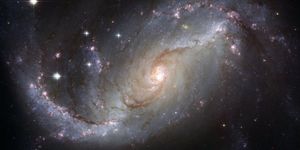Erigone Asteroids and the Search for Earth's Water Origins
What can asteroids teach us about the early solar system and were they responsible for bringing water to the Earth in its early history? This is what a recent study published in Icarus hopes to address as a team of international researchers investigated a specific family of asteroids known as Erigone asteroids, which orbit in the main asteroid belt between Mars and Jupiter, as part of the PRIMitive Asteroid Spectroscopic Survey (PRIMASS) project to help further constrain the processes that created our solar system billions of years ago, along with trying to determine if asteroids were responsible for bringing water to Earth, as well. This study holds the potential for researchers to establish new methods of analyzing asteroids, with the scientific community hypothesizing that asteroids hold the key to better understanding our solar system’s history.
“There are theories that the Earth could have received a fraction of its water from primitive asteroids in the early Solar System,” said Brittany Harvison, who is a PhD student at the University of Central Florida along with being a researcher at the Florida Space Institute (FSI), and lead author of the study. “A big portion of these theories is understanding how these primitive asteroids were transported into Earth’s path. So, exploring primitive asteroids in the Solar System today could help paint a picture of what was going on all those years ago.”
For the study, the researchers analyzed 25 asteroids of the Erigone family using archived infrared telescope data, with the reason Erigone asteroids are of interest is due to their high-water content, with Polana asteroids being known for their low-water content. The intent of the PRIMASS project is to learn more about collisional family of asteroids, or asteroids that are hypothesized to have once been part of a larger asteroid but were broken up due to a massive (or several massive) collision. Along with high-water content, Erigone asteroids also had yet to be studied for entry into the PRIMASS database, which made this study even more intriguing.
In the end, the researchers found that primitive asteroids within the inner solar system demonstrated varying levels of water content compared to Erigone and Polana asteroids, which challenges longstanding hypotheses as to where these primitive asteroids belong in terms of asteroid classification. The team aspires to broaden this research scope with the goal of ascertaining if asteroids were indeed responsible for brining water to Earth billions of years ago.
“There’s this fascination when I’m looking at this data and I’m examining something that’s millions of miles away,” said Harvison. “We can look back billions of years and learn the initial structure and composition of the early solar system by studying the surface of these asteroids. That’s always been something that excites me.”
What new discoveries will researchers make about primitive asteroids in the solar system in the coming years and decades? Only time will tell, and this is why we science!
As always, keep doing science & keep looking up!
Sources: Icarus, Planetary Science Institute, EurekAlert!, UCF Today
Featured Image: Artist’s illustration displaying how certain asteroid families, including Erigone, are created. (Credit: NASA/JPL-Caltech)








